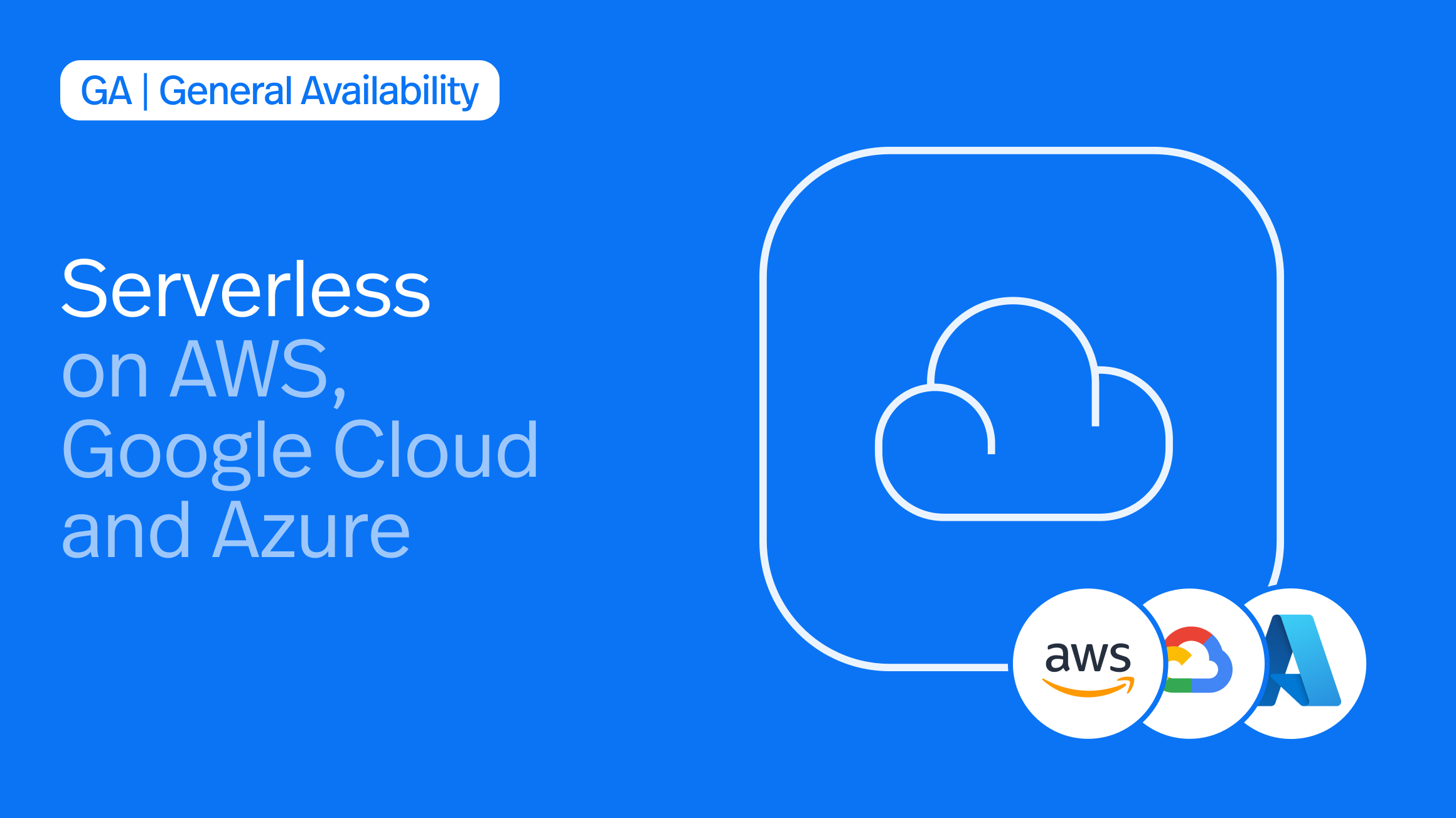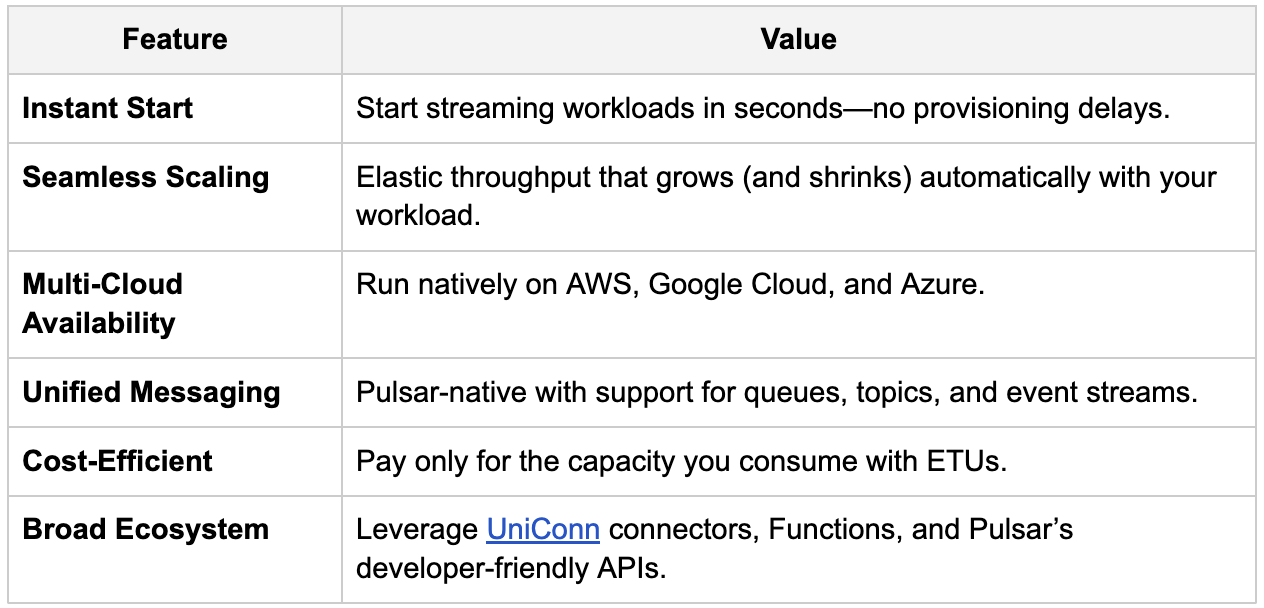StreamNative Serverless is Now Generally Available on AWS, Google Cloud, and Azure

On September 9, 2024, we introduced StreamNative Serverless in Public Preview, bringing instant start, seamless scaling, and effortless data streaming to developers and enterprises. Since then, we’ve seen tremendous adoption from organizations that want a fully managed, elastic, and cost-effective way to build and run real-time applications without worrying about infrastructure.
Today, we are excited to announce that StreamNative Serverless is now Generally Available (GA) on AWS, Google Cloud, and Azure. This marks a major milestone in making streaming and messaging accessible to everyone, regardless of scale or expertise.
Why StreamNative Serverless?
With StreamNative Serverless, anyone can get started with powerful event streaming and messaging capabilities in just a few clicks. There’s no infrastructure to provision, no clusters to size, and no operational overhead. The result is a pay-as-you-go model that ensures cost-effectiveness while giving developers and enterprises the freedom to innovate faster.
The true power of StreamNative Serverless lies in its ability to unify data streaming and messaging under a single, fully managed platform with multi-protocol support. Unlike traditional services locked to a single interface, StreamNative Serverless natively supports Pulsar, Kafka, and MQTT protocols, giving teams the flexibility to connect diverse applications, systems, and devices without rewriting code or re-architecting pipelines. Whether you’re building event-driven microservices, streaming analytics, or IoT applications, this seamless protocol interoperability ensures that developers can work with the tools and APIs they already know while benefiting from the elasticity, scalability, and simplicity of a serverless environment.
Core Capabilities of StreamNative Serverless

Elastic Throughput Units (ETUs)
At the heart of StreamNative Serverless is the Elastic Throughput Unit (ETU). ETUs provide a simple, elastic, and predictable way to measure and consume streaming capacity. Each ETU provides throughput and message capacity across multiple dimensions:
Serverless ETU Capacity and Limits
Per ETU capacity

Cluster maximum capacity

- Minimum ETU per cluster: 1
- Elasticity: Scale up seamlessly as workloads grow and scale back down when demand subsides.
This means developers and operators no longer need to size clusters upfront or worry about over-provisioning—ETUs handle elasticity for you.
The Power of UniConn: One API, Unlimited Connectivity
With Universal Connectivity for Kafka and Pulsar (UniConn), StreamNative Serverless makes it simple to connect to any ecosystem. Whether you’re integrating with Pulsar IO connectors or Kafka Connect-based connectors, you can easily bridge data across systems and clouds. This gives you access to a rich portfolio of pre-built connectors, reducing the time and effort needed to wire up modern data architectures.
With UniConn, debugging and troubleshooting connectors is simple and intuitive. Users can view and filter log files directly within the platform, making it easy to trace connector activity, identify issues, and resolve errors quickly. This streamlined debugging experience reduces downtime and accelerates development by giving teams clear visibility into connector performance and behavior.
Functions for Stream Processing
StreamNative Serverless also supports Functions, enabling lightweight stream processing and event-driven applications. Functions can be written in a variety of runtimes, including:
- Java
- Python
- Node.js
- WebAssembly (WASM)
This makes it easier for developers to write business logic directly within the data pipeline without deploying external processing frameworks.
A common use case for StreamNative Functions is building lightweight, custom stream processing logic directly within the data pipeline. Developers can use Functions to filter, transform, or enrich events in real time, implement routing logic to send data to the right topics or systems, or perform aggregations for analytics and monitoring. By embedding this logic close to the data, Functions simplify architectures and reduce the need for external processing frameworks.
StreamNative now features notifications for Functions—a new capability designed to help teams proactively monitor critical workloads. With built-in, preconfigured notification rules like function‑crash‑loop‑backoff and function‑oom‑killed, users gain visibility into common failure scenarios. Notifications can be enabled or disabled via the console, and when triggered, email alerts are sent immediately, along with follow-up emails once the incident is resolved. Recipients default to your organization’s technical contact (or billing contact if no technical contact is set), ensuring rapid awareness and response to runtime issues.
Serverless Pricing
StreamNative Serverless pricing is simple and transparent, based on the Elastic Throughput Unit (ETU). Each ETU costs $0.10 per hour (about $73 per month), and customers can start with just 1 ETU minimum. As workloads grow, additional ETUs can be added seamlessly, ensuring that you only pay for the capacity you actually use. This flexible, pay-as-you-go model means there’s no need to commit to large upfront infrastructure costs—you scale up or down as your data streaming demands change, with full cost predictability.

Get Started with StreamNative Serverless
With GA availability on AWS, Google Cloud, and Azure, StreamNative Serverless is ready for production workloads of any size. Whether you’re building next-generation data applications, connecting disparate systems, or processing streams in real time, StreamNative Serverless delivers an elastic, cost-effective, and developer-friendly platform. Sign up for a trial to get started.
Newsletter
Our strategies and tactics delivered right to your inbox




.png)

.png)
